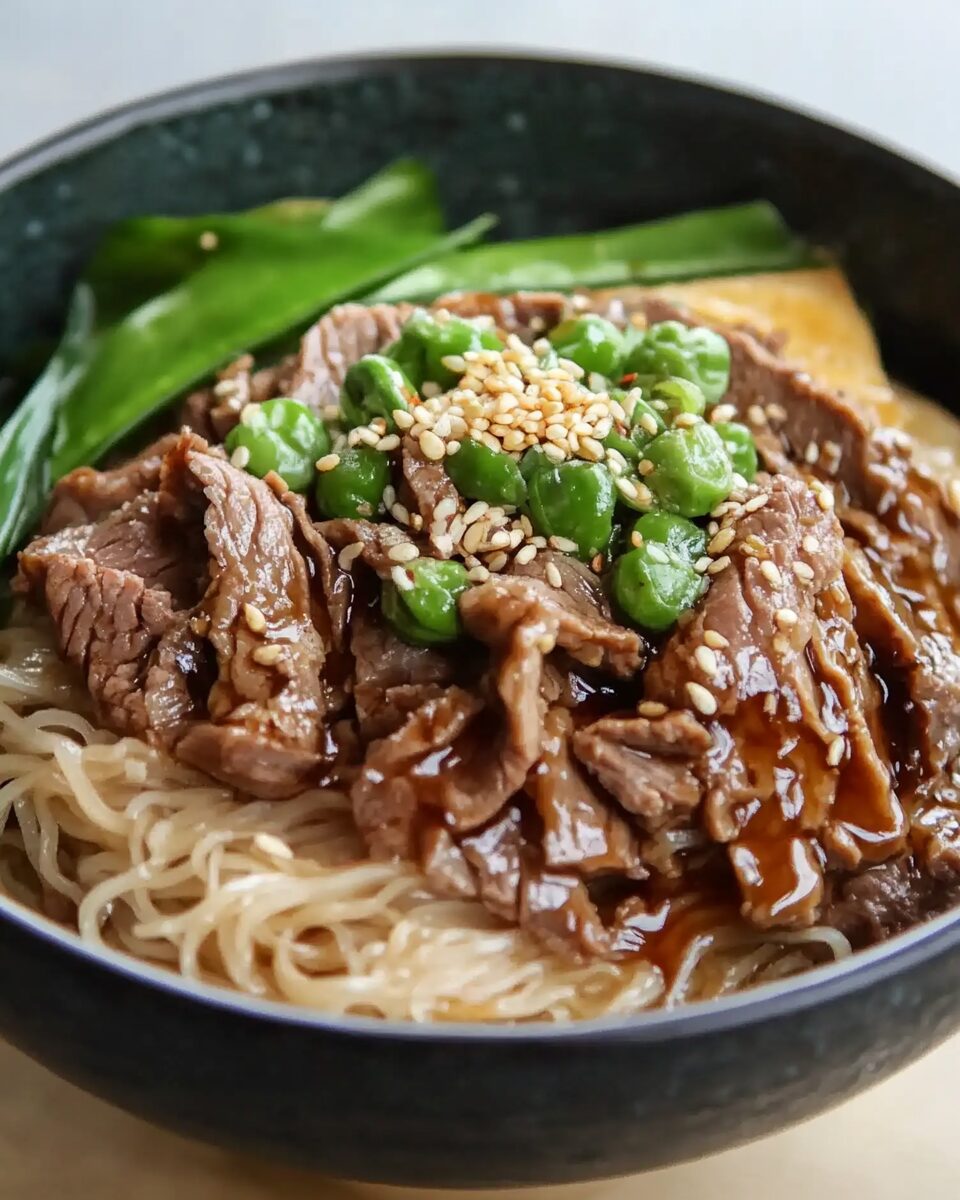Gyudon, translating to “beef bowl,” is a beloved Japanese dish that combines thinly sliced beef and onions simmered in a savory-sweet sauce, served atop a bowl of steamed rice. It’s a staple in Japanese cuisine, cherished for its comforting flavors and quick preparation, making it a popular choice for both home-cooked meals and fast-food dining. This dish is typically enjoyed as a main course for lunch or dinner.
Full Recipe:
Ingredients
- 1 large white onion
- 1 teaspoon vegetable oil
- ½ cup water
- 2 tablespoons soy sauce
- 1 tablespoon brown sugar
- 1 tablespoon mirin
- 1 tablespoon sake
- ½ pound beef ribeye steak, thinly sliced
- 1 tablespoon sesame seeds (optional)
- 2 green onions, thinly sliced (optional)
- 2 teaspoons pickled ginger (beni shoga) (optional)
- 1 sheet dried seaweed, cut into strips (optional)
Directions
- Prepare the Onion: Halve the onion and remove the central core. Slice the halves thinly.
- Sauté the Onion: In a large skillet or wok, heat the vegetable oil over high heat. Add the sliced onion and cook, stirring frequently, until it begins to brown, approximately 30 seconds.
- Simmer with Seasonings: Reduce the heat to medium-low. Pour in the water, soy sauce, brown sugar, mirin, and sake. Allow the mixture to simmer until the flavors meld and the onions soften, about 3 minutes.
- Add the Beef: Introduce the thinly sliced beef into the skillet. Cover and cook until the beef is fully cooked and tender, which should take 3 to 5 minutes.
- Serve: Divide the cooked beef and onion mixture between serving bowls. Garnish with sesame seeds, green onions, pickled ginger, and seaweed strips if desired. Serve hot over steamed rice.
Nutritional Facts
Per serving (excluding optional garnishes):
- Calories: 297
- Total Fat: 15g
- Saturated Fat: 5g
- Cholesterol: 41mg
- Sodium: 977mg
- Total Carbohydrates: 21g
- Dietary Fiber: 2g
- Sugars: 14g
- Protein: 16g
The History and Significance of Gyudon
Gyudon, or Japanese beef bowl, is one of Japan’s most beloved comfort foods. The dish consists of thinly sliced beef and onions simmered in a savory-sweet sauce, served over a bowl of steaming rice. Its name, “gyudon,” comes from “gyu” (beef) and “don” (short for “donburi,” meaning rice bowl). Originating in the late 19th century, this dish has since become a staple in Japanese households and restaurants, offering a quick, filling, and affordable meal.
The roots of gyudon can be traced back to sukiyaki, a hot pot dish that became popular in Japan during the Meiji era (1868–1912). During this time, Western influence brought beef into Japanese cuisine, which was previously rare due to Buddhist dietary restrictions. Over time, a simpler and faster version of sukiyaki emerged, evolving into the modern-day gyudon. Today, the dish is widely available in Japan, from home kitchens to fast-food chains like Yoshinoya and Sukiya.
The Appeal of Gyudon
Gyudon is loved for its combination of flavors and textures. The thin slices of beef absorb the rich umami of the sauce, which typically includes soy sauce, mirin, sugar, and sake. The onions become soft and slightly sweet, complementing the beef’s savory depth. When served over warm rice, the sauce seeps into the grains, making every bite satisfying.
One of the reasons for gyudon’s enduring popularity is its versatility and ease of preparation. It requires minimal ingredients, making it an ideal dish for busy individuals and families. Unlike other traditional Japanese dishes that take time to prepare, gyudon can be cooked in less than 30 minutes, making it an excellent option for quick lunches and dinners.
Regional and International Variations
Although the classic gyudon recipe remains the same, several regional and international variations have emerged:
- Tokyo-Style Gyudon: The most common version, featuring beef simmered in a slightly sweet sauce made of soy sauce, mirin, and sugar.
- Osaka-Style Gyudon: Uses a thicker sauce with a stronger umami profile, sometimes incorporating dashi for extra depth.
- Kansai-Style Gyudon: Often includes a raw egg on top, which adds creaminess when mixed with the hot rice.
- American-Inspired Gyudon: Some Western adaptations include ingredients like mushrooms, garlic, or Worcestershire sauce for a bolder flavor.
- Korean-Influenced Gyudon: A spicier version incorporating gochujang (Korean chili paste) or kimchi.
Nutritional Benefits of Gyudon
Gyudon is not just a delicious dish but also provides essential nutrients:
- Protein: The beef in gyudon is a rich source of protein, which is crucial for muscle growth and repair.
- Carbohydrates: The rice provides energy and helps keep you full.
- Healthy Fats: If prepared with lean cuts of beef, gyudon can offer healthy fats necessary for overall well-being.
- Vitamins and Minerals: Onions contain antioxidants and vitamin C, while the beef provides iron and B vitamins.
To make gyudon even healthier, some people substitute brown rice for white rice, use lean beef, or add more vegetables such as spinach or mushrooms.
Toppings and Side Dishes
One of the best aspects of gyudon is its customizability. In Japan, it is common to add toppings to enhance the dish’s flavor and texture. Some popular toppings include:
- Egg: A raw or soft-boiled egg adds creaminess when mixed into the rice.
- Pickled Ginger (Beni Shoga): Provides a tangy contrast to the savory beef.
- Shichimi Togarashi: A seven-spice blend that adds heat and complexity.
- Green Onions: Enhance freshness and color.
- Tofu or Mushrooms: A great way to add protein and make the dish more filling.
Gyudon is often served with miso soup, a small salad, or a side of pickled vegetables to create a well-balanced meal.
Why Gyudon is a Comfort Food
Like many beloved comfort foods, gyudon is associated with warmth, nostalgia, and home-cooked meals. Its rich, umami-packed sauce and tender beef create a sense of satisfaction, making it an ideal dish for chilly evenings or busy days when a quick and hearty meal is needed. Many Japanese families prepare gyudon when they need a simple yet fulfilling meal, and its affordability has made it a go-to dish for students, workers, and travelers alike.
Conclusion
Gyudon is a perfect example of Japanese comfort food—simple, flavorful, and satisfying. Its history, versatility, and ease of preparation have made it a beloved dish in Japan and beyond. Whether enjoyed as a quick meal or customized with various toppings and side dishes, gyudon remains a timeless favorite that brings warmth and nourishment to every bowl.






